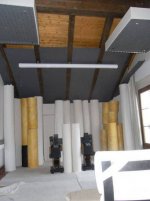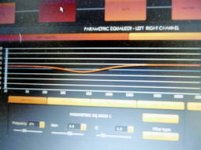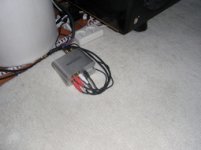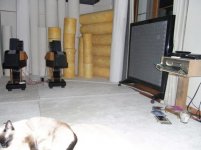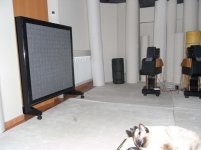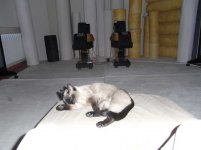Dear All,
Another innovative product from our Engineering Team!
For those of you thinking about Ambiophonics but either don't want a PC lying around their living room nor could afford existing products, our team pulled together a low cost AmbioPhonics processor called miniAMBIO. Please read more info under the Ambio4YOU.com website.
Datasheet of miniAMBIO is available here for more info.
Don't know what Ambiophonics is all about? Please read more on the following links:
Ambio4YOU - Ambiophonic DSP | Ambio4YOU systems
Ambio4YOU - Ambiophonic DSP | Ambiophonics Theory
And of course the Ambiophonics institute @ ambiophonics.org
Hope you like it and as usual, don't hesitate to post your questions here or on the ambio4you.com forum if any.
DevTeam
Another innovative product from our Engineering Team!
For those of you thinking about Ambiophonics but either don't want a PC lying around their living room nor could afford existing products, our team pulled together a low cost AmbioPhonics processor called miniAMBIO. Please read more info under the Ambio4YOU.com website.
Datasheet of miniAMBIO is available here for more info.
Don't know what Ambiophonics is all about? Please read more on the following links:
Ambio4YOU - Ambiophonic DSP | Ambio4YOU systems
Ambio4YOU - Ambiophonic DSP | Ambiophonics Theory
And of course the Ambiophonics institute @ ambiophonics.org
Hope you like it and as usual, don't hesitate to post your questions here or on the ambio4you.com forum if any.
DevTeam
In answer to the questions from Gooki,
miniDSP runs on a 48kHz core while miniAMBIO runs on a 96kHz core.
The only way you could do it would be using miniAMBIO bare board stacked with a miniDIGI. We will soon enable a miniDIGI board in the shopping cart to allow:
SPDIF in - > RACE ambiophonics -> SPDIF out. A complete Digital end to end Ambiophonics solution running at 96kHz.
Hope this info helps
Yes, we'll soon add it to the online shopping cart. Allowing those of you who want to DIY or integrate in their custom products an easier task.- Is it possible to purchase the Ambio4YOU without the case?
Although very similar on the hardware, miniDSP and miniAMBIO are actually different boards and not compatible..Can the Ambio4YOU send the output digitally to the MiniDSP? or the other way round - MiniDSP ouput over digital to Ambio4YOU?
miniDSP runs on a 48kHz core while miniAMBIO runs on a 96kHz core.
The only way you could do it would be using miniAMBIO bare board stacked with a miniDIGI. We will soon enable a miniDIGI board in the shopping cart to allow:
SPDIF in - > RACE ambiophonics -> SPDIF out. A complete Digital end to end Ambiophonics solution running at 96kHz.
Hope this info helps
I have configured my ambios and they are already working.
I finally have ambiophonic sound without a physical barrier or a noisy and annoying computer!!! Good job, Ambio4you!
Good job, Ambio4you!
By the way, the equalizer is a very important feature to good ambio sound.
One suggestion: is it possible for you to include features such as the so called center or space parameters available in electro music website´s AmbiophonicDSP´s software implementation? Could that be done as a software update and used with the current boards or would it be necessary to modify the chips themselves? Those are features that Robin Miller and Howard Moscovitz developed and I have found to really improve the ambiophonic experience, sort of the icing on the cake so to speak.
Thanks for catering to the growing number of ambiophonic fans out there who don´t have $2,000 to spare or like computer fans buzzing along with our music.
I finally have ambiophonic sound without a physical barrier or a noisy and annoying computer!!!
By the way, the equalizer is a very important feature to good ambio sound.
One suggestion: is it possible for you to include features such as the so called center or space parameters available in electro music website´s AmbiophonicDSP´s software implementation? Could that be done as a software update and used with the current boards or would it be necessary to modify the chips themselves? Those are features that Robin Miller and Howard Moscovitz developed and I have found to really improve the ambiophonic experience, sort of the icing on the cake so to speak.
Thanks for catering to the growing number of ambiophonic fans out there who don´t have $2,000 to spare or like computer fans buzzing along with our music.
Attachments
Last edited:
Glad to hear that you're happy with your Ambio Setup! 
A big listening room, that's neat..we would never get this kind of space in HK.. :-( . Do you mind telling us what type of speakers you're using and how this miniAMBIO setup differs from your previous install? Picture is a bit small..
As for your question, we don't know much about what Electromusic is doing (don't think it's open source...) so can't answer that one. We could investigate a bit more later to see if it's maybe possible to partner with the electro-sonic guys for this one... We'll try to have a look at it one of these days.
Have fun!
A big listening room, that's neat..we would never get this kind of space in HK.. :-( . Do you mind telling us what type of speakers you're using and how this miniAMBIO setup differs from your previous install? Picture is a bit small..
As for your question, we don't know much about what Electromusic is doing (don't think it's open source...) so can't answer that one. We could investigate a bit more later to see if it's maybe possible to partner with the electro-sonic guys for this one... We'll try to have a look at it one of these days.
Have fun!
The speakers are diy. An ongoing project under constant revision. They used to be placed side by side when I was using a physical barrier and were moved to a 20º as seen from the listening chair for electronic crosstalk cancellation. This seems the best position for Ambio4you as it was with the other software I´ve tried.
I find that a given system´s frequency curve does need to be slightly tweaked once it undergoes cancellation and I have been doing that by modifying my active crossovers. Your equalizer comes in really handy particularly for users with non active speakers.
I will keep my fingers crossed that you can pull off a colaboration with electro-music´s implementation. Then you would be offering the undisputable best both in sound and convenience, (as long as price doesn´t sky-rocket).
Regards.
I find that a given system´s frequency curve does need to be slightly tweaked once it undergoes cancellation and I have been doing that by modifying my active crossovers. Your equalizer comes in really handy particularly for users with non active speakers.
I will keep my fingers crossed that you can pull off a colaboration with electro-music´s implementation. Then you would be offering the undisputable best both in sound and convenience, (as long as price doesn´t sky-rocket).
Regards.
Last edited:
Where I said sound and convenience I meant flexibility and convenience. The sound of your unit is indeed top-notch, as transparent as it gets.
I was thinking of having the posibility to fine-tune the final sound to each user´s taste or a particular recording. Certain records may sound best adding a little depth to the sound or enlargening the soundstage.
In my experience with electronic crosstalk there is one recursion level that sounds best. Go beyond it and you get the impression of a wider soundstage but it will not be satisfying overall. So the correct value for your system and room, once set , should not be modified.
However, by adding one or two user-configurable parameters such as a slight reduction of central sounds ( I am just guessing and don´t know what I´m talking about) you can improve the experience a bit.
I am really enjoying your device (even as I type these words). It sounds fabulous. And the software is a breeze to use.
I was thinking of having the posibility to fine-tune the final sound to each user´s taste or a particular recording. Certain records may sound best adding a little depth to the sound or enlargening the soundstage.
In my experience with electronic crosstalk there is one recursion level that sounds best. Go beyond it and you get the impression of a wider soundstage but it will not be satisfying overall. So the correct value for your system and room, once set , should not be modified.
However, by adding one or two user-configurable parameters such as a slight reduction of central sounds ( I am just guessing and don´t know what I´m talking about) you can improve the experience a bit.
I am really enjoying your device (even as I type these words). It sounds fabulous. And the software is a breeze to use.
In answer to the questions from Gooki,
Yes, we'll soon add it to the online shopping cart. Allowing those of you who want to DIY or integrate in their custom products an easier task.
Although very similar on the hardware, miniDSP and miniAMBIO are actually different boards and not compatible..
miniDSP runs on a 48kHz core while miniAMBIO runs on a 96kHz core.
The only way you could do it would be using miniAMBIO bare board stacked with a miniDIGI. We will soon enable a miniDIGI board in the shopping cart to allow:
SPDIF in - > RACE ambiophonics -> SPDIF out. A complete Digital end to end Ambiophonics solution running at 96kHz.
Hope this info helps
Does this mean the miniDSP is on a daughterboard of the ambio, and everything is working at 96khz?
Could I have Ambio, and Stereo 2 way crossovers with that combination?
I am really excited about the sound I´m getting after toeing out the speakers quite a bit and adding absorption to where they´re aiming at. It is the same as what I got from my physical barrier set-up, which I had not been able to replicate since I moved to electronic crosstalk cancellation. 
For those who are ready to try, don´t give up, it may take a lot of experimentation and tweaking but what you get in the end is something much better than what the standard stereo triangle has been offering you.
For those who are ready to try, don´t give up, it may take a lot of experimentation and tweaking but what you get in the end is something much better than what the standard stereo triangle has been offering you.
Attachments
Sorry but no, that's not what we meant. miniDSP runs at 48kHz and this will most likely not change as we realized that going to 96kHz was bringing little value in terms of results AND halving the DSP power.Does this mean the miniDSP is on a daughterboard of the ambio, and everything is working at 96khz?
Could I have Ambio, and Stereo 2 way crossovers with that combination?
What gooki was referring to is having a setup with miniDIGI as the input and output. Processing being done by a miniAMBIO board. A miniDSP board wouldn't be able to talk to this stack running I2S at 96kHz because it's running its core at 48k.
Hope this makes sense
I am really excited about the sound I´m getting after toeing out the speakers quite a bit and adding absorption to where they´re aiming at. It is the same as what I got from my physical barrier set-up, which I had not been able to replicate since I moved to electronic crosstalk cancellation.
For those who are ready to try, don´t give up, it may take a lot of experimentation and tweaking but what you get in the end is something much better than what the standard stereo triangle has been offering you.
Very interesting.. We never tried that configuration but now thinking about it!
interesting stuff.. Keep feeding us with your findings. So much to share to the Ambio Community. If you have some time to share some pics on the Ambio showcase section, it would be much appreciated as well!
I would like to comment on my findings after a great deal of experimentation with the ambio4you device. Will post pictures as soon as I can borrow a camera again. The speakers are now touching each other (5 degree angle from the listening point?) and facing forward with no toe in or out whatsoever, 10 us delay (shortest available after no delay at all), race attenuation at -10 and cancellation limited to 200-to-6000 hz-range. I had never found this limited range processing satisfying before but, what do you know, that´s how it sounds best to my ears now.
I was not entirely happy with the bigger 20-30º angle. I entertained the idea that the closer the speakers the more solid the center sounds would be, and it does sound a lot better to me this way.
I was not entirely happy with the bigger 20-30º angle. I entertained the idea that the closer the speakers the more solid the center sounds would be, and it does sound a lot better to me this way.
@Poldus,
We'd indeed be interested to hear more about your findings! It's always fun to see when new configurations are discovered.. I wonder if the real advantage in your case isn't just a coupling effect (e.g. line array technology when drivers are less than 1/2 wavelength apart) combined with some ambiophonics theory. Though at 10uS, it does sound very short (more so like 100uS in a 20deg angle).
Anyway, if you get some time, please share with us here and/or on our forum: Ambio4YOU - Ambiophonic DSP | Ambiophonics Showcase - AmbioFORUM
Thanks
DevTeam
We'd indeed be interested to hear more about your findings! It's always fun to see when new configurations are discovered.. I wonder if the real advantage in your case isn't just a coupling effect (e.g. line array technology when drivers are less than 1/2 wavelength apart) combined with some ambiophonics theory. Though at 10uS, it does sound very short (more so like 100uS in a 20deg angle).
Anyway, if you get some time, please share with us here and/or on our forum: Ambio4YOU - Ambiophonic DSP | Ambiophonics Showcase - AmbioFORUM
Thanks
DevTeam
Monopole, and trying full range cancellation again with 41us delay.poldus - are you using dipole or monopole speakers
I´ll stop posting for a while until I find a setting that I´m happy with over the long run and not just a couple of days or my posts will be totally useless to anybody.
Monopole, and trying full range cancellation again with 41us delay.
I´ll stop posting for a while until I find a setting that I´m happy with over the long run and not just a couple of days or my posts will be totally useless to anybody.
FYI, from the investigation we've done in various installations and chats with Ralph Glasgal, we've found that the following default settings may be a bit more optimal than the one currently used in the plug-in:
- Attenuation: -2.7 dB
- Delay: 104uS
- LP and HP for RACE: 90 to 6kHz
Maybe worth a try for those of you still "tweaking" their miniAMBIO...
Have a pleasant Ambio-Experience!
One suggestion: is it possible for you to include features such as the so called center or space parameters available in electro music website´s AmbiophonicDSP´s software implementation?
As for your question, we don't know much about what Electromusic is doing (don't think it's open source...) so can't answer that one.
I don't know the exact algorithm electro was using, but my simplistic view on their idea is basically a mid/side adjustment in front of the ambio processing chain. It seems to give similar but perhaps not exact results. Want more center, adjust the mid (L+R), want more ambiance, adjust the side (L-R). In the VST world I was using voxengo's MSED mid/side plugin.
Last edited:
....
The only way you could do it would be using miniAMBIO bare board stacked with a miniDIGI. We will soon enable a miniDIGI board in the shopping cart to allow:
SPDIF in - > RACE ambiophonics -> SPDIF out. A complete Digital end to end Ambiophonics solution running at 96kHz.
Hope this info helps
Hi,
Is there any product update for Ambio with D-in and D-out ? I don't see it in your web site, neither in Home Page
Thanks a lot.
- Status
- This old topic is closed. If you want to reopen this topic, contact a moderator using the "Report Post" button.
